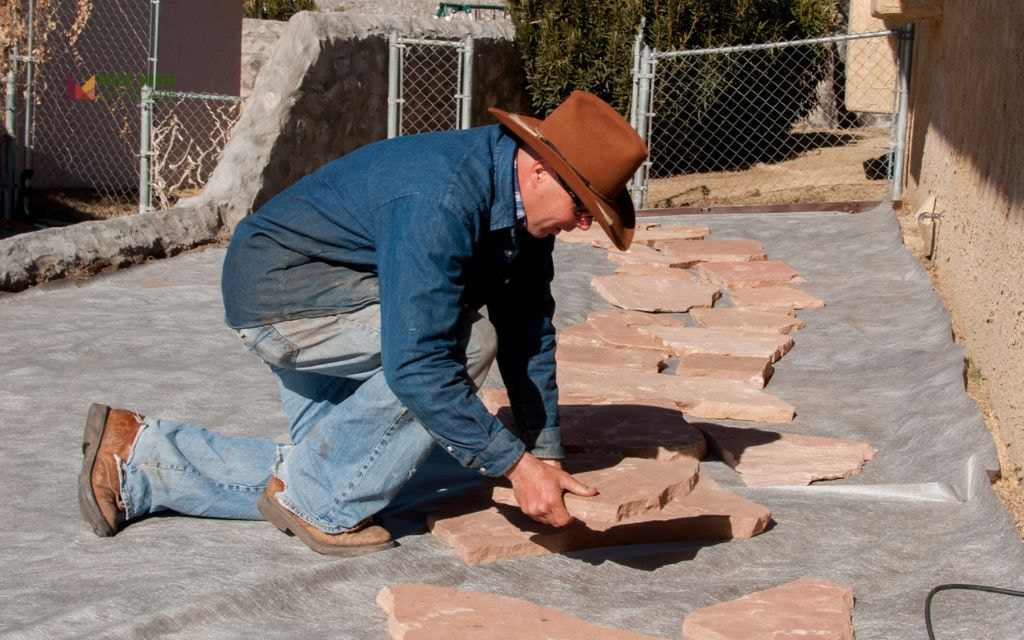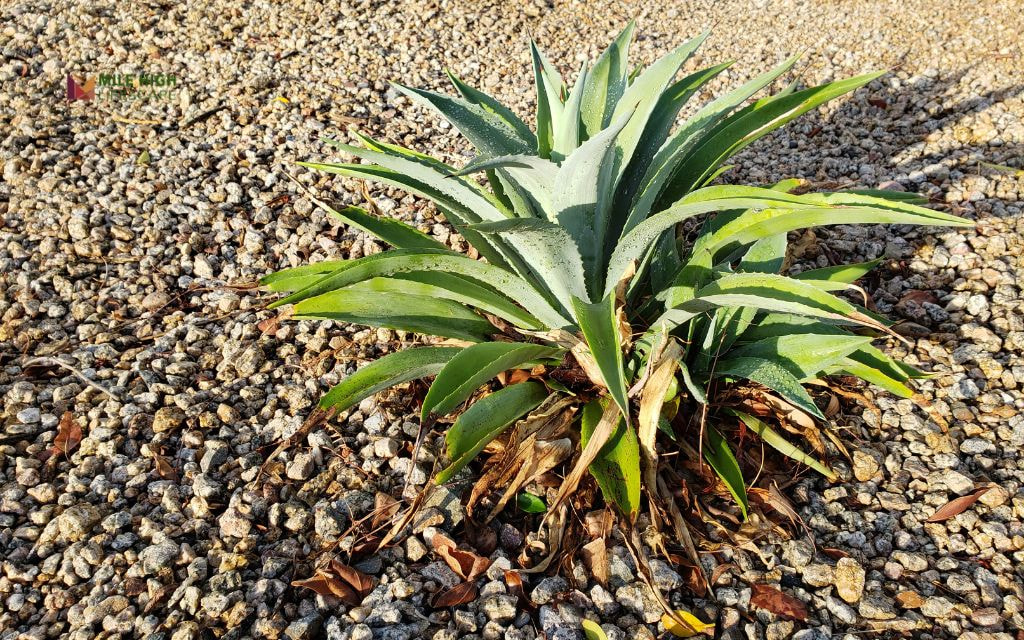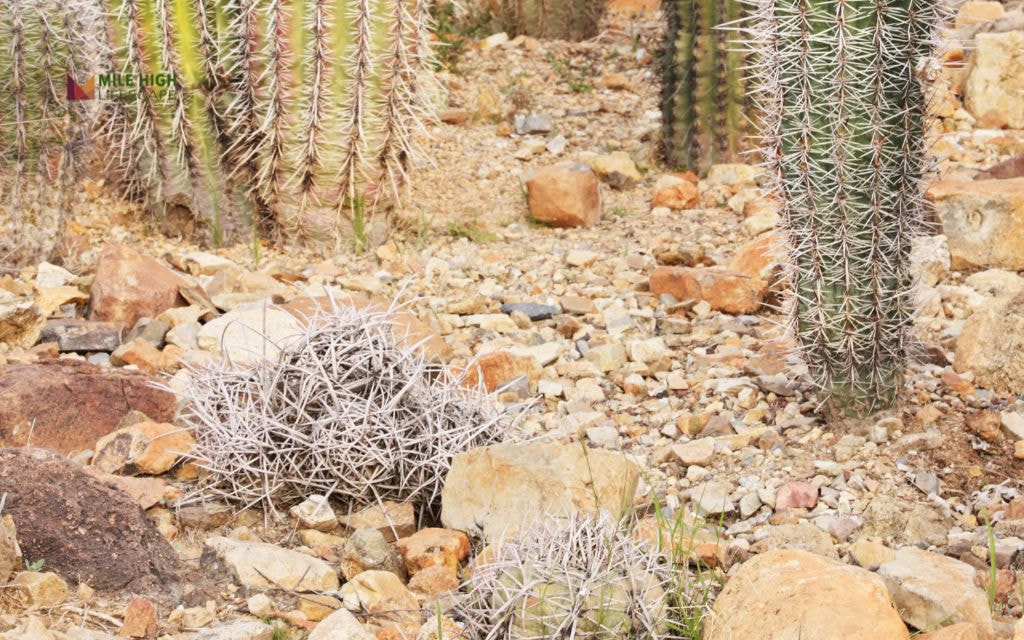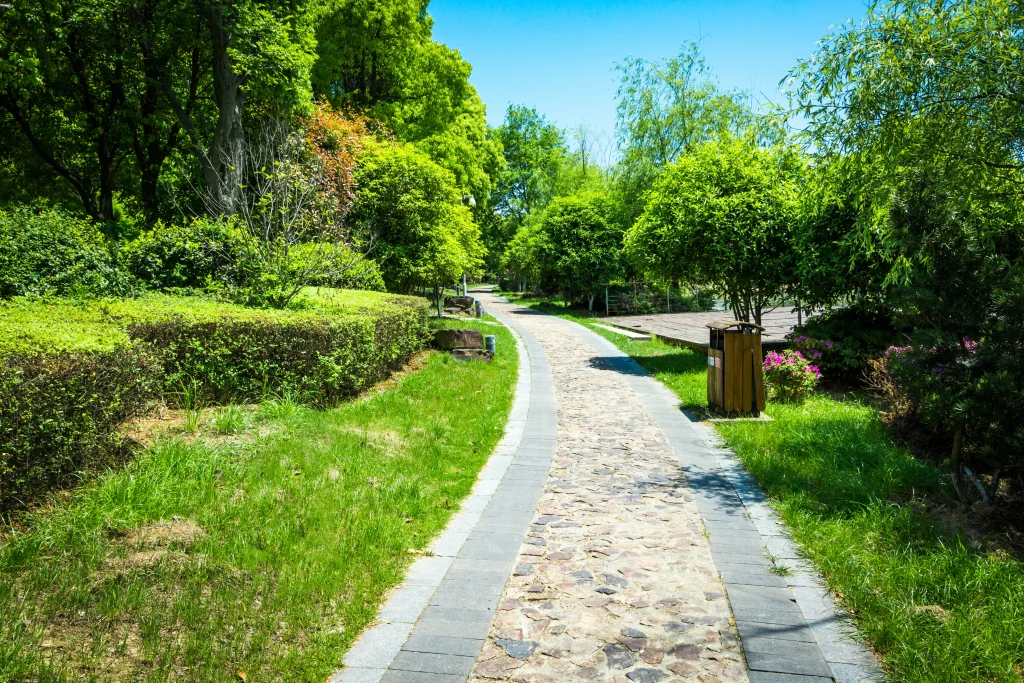How to xeriscape your yard starts with understanding what xeriscaping means. Xeriscaping a yard involves a water-wise approach to landscaping, utilizing drought-tolerant plants, efficient irrigation, and other techniques to minimize water usage.
Colorado homeowners face unique challenges with water restrictions, high altitude conditions, and unpredictable weather patterns. Xeriscaping helps cut water bills by up to 60%, reduce maintenance time, and create landscapes that thrive through Colorado’s weather.
This guide helps you discover plant selections perfect for Denver’s conditions, installation techniques that prevent costly mistakes, and maintenance strategies that keep your xeriscape thriving year-round.
Step-by-Step: How to Xeriscape Your Yard in Colorado
Step 1: Make a Plan for Your Space
Smart xeriscaping begins with thoughtful planning. Walk your property during different times of day to observe sun patterns, drainage areas, and existing microclimates. Denver’s intense sun creates distinct zones that require different plant approaches.
Sketch your yard using graph paper or free templates. Mark areas that receive full sun (6+ hours daily), partial shade, and full shade. Identify high-use zones like patios, play areas, and pathways versus low-traffic sections perfect for ornamental plantings.
Consider your household’s needs. Do you need pet-friendly spaces? Entertainment areas? Privacy screening? These factors influence plant selection and hardscape placement.
Create functional zones within your design. Group plants with similar water needs together – this concept, called hydrozoning, maximizes irrigation efficiency. Place thirsty plants near downspouts or in moist areas, while drought-tolerant species thrive in hot, dry sections.
Step 2: Remove Existing Lawn or Plants
Traditional turf removal sets the foundation for successful xeriscaping. It includes 3 effective methods: sod cutting, solarization, and sheet mulching.
- Sod cutting: Rent a sod cutter for large areas or use a spade for smaller sections. Cut 2-3 inches deep to remove roots and minimize regrowth. Denver’s clay soil requires sharp blades and may need pre-watering for easier cutting.
- Solarization: Cover unwanted grass with clear plastic, securing edges with soil or rocks. The trapped heat kills grass and weeds over 6-8 weeks. This method works best on areas receiving full sun.
- Sheet mulching, also called lasagna gardening, smothers existing vegetation with cardboard layers topped with organic mulch. This method improves soil while eliminating grass, though it requires 3-6 months for complete decomposition.
Step 3: Improve the Soil (If Needed)
Denver’s soil challenges many plants with poor drainage and compaction issues. Most xeric plants prefer well-draining soil, making soil amendment crucial for success.
Test your soil’s drainage by digging a 12-inch hole and filling it with water. If water remains after 24 hours, drainage improvement is necessary.
Contact a professional lab for soil testing services to determine pH levels and nutrient content. Denver’s alkaline soil (pH 7.0-8.5) suits most xeric plants without additional amendments.
Add organic compost to planting areas only – avoid amending entire yards, which can create drainage problems. Mix 2-4 inches of compost into the top 8-12 inches of soil in designated planting beds.
Step 4: Install or Modify Irrigation
Convert existing sprinkler systems to drip irrigation or micro-spray systems that deliver water directly to plant root zones.
- Drip irrigation reduces water usage by 30-50% compared to traditional sprinklers while providing consistent moisture to plant roots. Install separate zones for different plant types – trees, shrubs, perennials, and groundcovers each require different watering schedules.
- Smart controllers adjust watering based on weather conditions, seasonal changes, and plant needs. These devices can reduce irrigation water use by an additional 15-20% while preventing overwatering.
- Create a hydrozoning map showing irrigation coverage. Group plants with similar water requirements together to maximize system efficiency.
- Install pressure-compensating emitters to ensure consistent water delivery across varying elevations common in Denver landscapes. Include filtration systems to prevent clogging from Denver’s hard water.

Step 5: Choose the Right Xeric Plants for Colorado
Choosing the right plants for xeriscaping determines your xeriscape’s success. Focus on native species and regionally adapted plants of Denver.
Perennials provide seasonal color with minimal water needs:
- Penstemon species offer spring through fall blooms in purple, pink, and white.
- Yarrow creates spreading masses of yellow, pink, or white flowers that attract beneficial insects.
- Blanket Flower produces orange and red blooms from spring until frost.
Native grasses add texture and movement while requiring minimal maintenance:
- Blue Grama grass creates fine-textured groundcover perfect for naturalized areas.
- Little Bluestem develops bronze-red fall color and provides winter interest with seed heads that attract birds.
Groundcovers replace traditional lawn in low-traffic areas:
- Creeping Thyme forms dense, fragrant mats with purple flowers.
- Ice Plant provides succulent texture with bright spring blooms.
- Both species handle foot traffic and spread naturally to fill spaces.
Shrubs create structure and provide wildlife habitat:
- Rabbitbrush produces masses of yellow fall flowers that attract butterflies.
- Sumac species offer brilliant fall color and winter interest with persistent berry clusters that feed birds through harsh winters.
Step 6: Lay Down Mulch and/or Decorative Rock
Choose organic mulches for planting beds and inorganic materials for accent areas and pathways.
- Organic mulches include shredded bark, wood chips, and leaf mold. These materials decompose gradually, improving soil structure while providing ongoing weed suppression. Apply 2-4 inches thick, keeping mulch 2-3 inches away from plant stems to prevent moisture-related diseases.
- Inorganic mulches work well for accent areas and high-traffic zones. Pea gravel creates excellent drainage while providing neutral colors that complement plant materials. Decomposed granite compacts into stable surfaces perfect for pathways. River rock adds visual interest and helps frame planting beds.
How to xeriscape with rocks requires strategic placement rather than wholesale coverage:
- Use rocks to create defined edges between different landscape zones.
- Place larger boulders as focal points or to create visual anchors in large spaces.
- Avoid covering entire areas with rock, which creates heat islands and limits plant establishment.
Step 7: Add Paths, Patios, and Hardscaping (Optional)
Hardscape features create structure and functionality while reducing maintenance needs. Use colors and textures that enhance rather than overwhelm the natural beauty of drought-tolerant plantings.
- Gravel pathways work well in xeriscapes, providing excellent drainage and easy maintenance. Use decomposed granite or crushed rock for stable surfaces that complement surrounding plantings. Edge pathways with metal or stone borders to prevent spreading.
- Flagstone patios are popular in xeriscaping designs for creating outdoor living spaces with low maintenance. Choose locally sourced stone that complements Colorado’s natural landscape.
- Permeable surfaces allow water infiltration while providing functional hardscape. Permeable pavers, porous concrete, and gravel surfaces qualify for Denver Water rebate programs while reducing stormwater runoff.
- Consider fire pits, retaining walls, or water features as focal points. These elements add visual interest while serving practical functions. Fire pits extend outdoor seasons, retaining walls manage slope issues, and water features attract wildlife to your xeriscape.
Step 8: Maintain Smartly and Seasonally
Xeriscapes require different maintenance approaches than traditional landscapes. The first growing season demands attention to establish plants, while mature xeriscapes need minimal intervention.
During establishment, water regularly but deeply to encourage deep root development. Check soil moisture 2-3 inches below surface – water when dry at this depth. Newly planted xeriscapes may need weekly watering during hot, dry periods.
Weed control proves critical during the first year when plants haven’t yet filled their spaces. Pull weeds when soil is moist after irrigation or rainfall. Maintain mulch layers to suppress weed germination and conserve soil moisture.
Most xeric plants require minimal fertilization. Focus on maintaining healthy soil biology through organic mulching rather than synthetic fertilizer applications.
Xeriscaping Tips for Colorado’s Climate
Understanding these factors helps ensure your xeriscape landscape thrives through seasonal extremes:
- Plant timing matters significantly in Colorado. Spring planting allows root development before summer heat, while fall planting takes advantage of cooler temperatures and autumn moisture. Avoid planting during hot summer months.
- Mulch serves multiple functions beyond weed suppression in Colorado’s climate. Organic mulches moderate soil temperatures, protecting roots from freeze-thaw cycles that damage plants.
- Avoid gravel-only landscape designs that create heat islands around your home. While decorative rock works well as accent material, large areas of rock or gravel reflect heat and increase cooling costs.
- Wind exposure affects plant selection and placement in Colorado landscapes. Strong chinook winds can desiccate plants and increase watering needs. Use windbreaks, strategic plant placement, and adequate mulching to protect sensitive species from wind damage.
- Slope management prevents erosion while creating diverse planting opportunities. South-facing slopes receive intense sun and require the most drought-tolerant species. North-facing slopes stay cooler and moister, supporting a wider range of plants with moderate water needs.

How to Maintain Your Colorado Xeriscape
Seasonal maintenance keeps your xeriscape healthy while minimizing time and resource investment.
Understanding what tasks to perform when prevents problems and ensures long-term success:
Spring Tasks (March-May)
- Inspect drip irrigation systems for winter damage and clogs.
- Clean emitters and check for proper water distribution.
- Prune perennials before new growth begins, cutting back dead stems to make room for fresh growth.
- Top off mulch layers that have decomposed or blown away during winter winds.
Summer Tasks (June-August)
- Monitor soil moisture levels during hot, dry periods.
- Water deeply but infrequently to encourage deep root development.
- Perform spot-checks for weeds, removing them while small and easy to manage.
- Deadhead flowers on perennials to encourage continued blooming.
Fall Tasks (September-November)
- Trim ornamental grasses before winter storms weigh down stems.
- Cut back dormant perennials after frost kills foliage.
- Divide overcrowded perennials and replant sections to expand your landscape.
- Apply winter mulch around tender plants for protection.
Winter Tasks (December-February)
Minimal maintenance required during dormant season.:
- Monitor mulch coverage and add material where needed.
- Protect evergreen shrubs from desiccating winds with burlap screens.
- Plan changes or additions for the coming growing season.
Other Task:
- Weed control remains crucial during the first 6-12 months while plants establish and fill their spaces. Pull weeds when soil is moist, removing entire root systems to prevent regrowth.
- Reapply organic mulch every 1-2 years as materials decompose. Fresh mulch maintains soil moisture conservation and temperature moderation while providing ongoing weed suppression.
- Drip irrigation systems need annual flushing and inspection at the beginning of each growing season. Replace damaged emitters and clear clogged lines.
- Occasional pruning of woody shrubs maintains shape and encourages healthy regrowth. Prune spring-flowering shrubs immediately after blooming. Summer and fall-flowering species can be pruned during dormant season. Remove dead, damaged, or crossing branches annually.

Conclusion
Each successful xeriscaping project builds confidence and knowledge for future improvements. Your water-wise landscape saves money on utility bills, reduces maintenance time, and supports Colorado’s native wildlife. Explore these front yard xeriscape ideas Colorado to inspire your next project.
Long-term benefits include increased property values, improved drought resilience, and the satisfaction of creating a landscape that thrives in harmony with Colorado’s remarkable climate.
Take the first step toward your water-smart landscape today.
If you’re wondering “Are there any xeriscaping services near Denver?” Don’t worry! We’re here to help you create the xeriscape of your dreams.
For nearly two decades, Mile High Lifescape has been proudly serving the Denver Metro area as the go-to landscape company. With a reputation for excellence, we offer a comprehensive range of professional landscaping and lawn care services.
Contact us today.
Frequently Asked Questions (FAQs)
How do you prepare ground for xeriscape?
To prepare ground for xeriscaping, you should start by removing existing turf and weeds through sod cutting, solarization, or sheet mulching. Test soil drainage and amend heavy clay areas with compost to improve root zone conditions. Focus soil improvements on specific planting areas rather than entire yards to maintain natural drainage patterns.
Do I need a permit to xeriscape in Denver?
No, permits are not required for most xeriscaping projects in Denver. However, check with your HOA for any landscape restrictions or requirements.
What is the downside of xeriscape?
The main downsides of xeriscaping include higher upfront installation costs, limited plant selection compared to traditional gardens, and potential for overheating if designed with too much hardscape. Establishment requires patience as plants take time to mature and fill spaces. Some people miss the green appearance of traditional lawns.
How to xeriscape cheaply?
To xeriscape affordably in Colorado, start small with high-impact areas like front entrances or problem zones:
- Use Denver Water rebates to offset costs.
- Choose locally available materials like decomposed granite instead of imported decorative rock.
- Grow plants from seeds or divisions rather than purchasing mature specimens.
- Install irrigation systems yourself using drip kits from local suppliers.
For a breakdown of how much does it cost to xeriscape a yard, including tips to xeriscape cheaply, see our full guide.
Is xeriscape low maintenance?
Yes, established xeriscapes require significantly less maintenance than traditional landscapes. They eliminate mowing, reduce fertilizer needs, and require less frequent watering. However, the first year demands attention for plant establishment and weed control.
